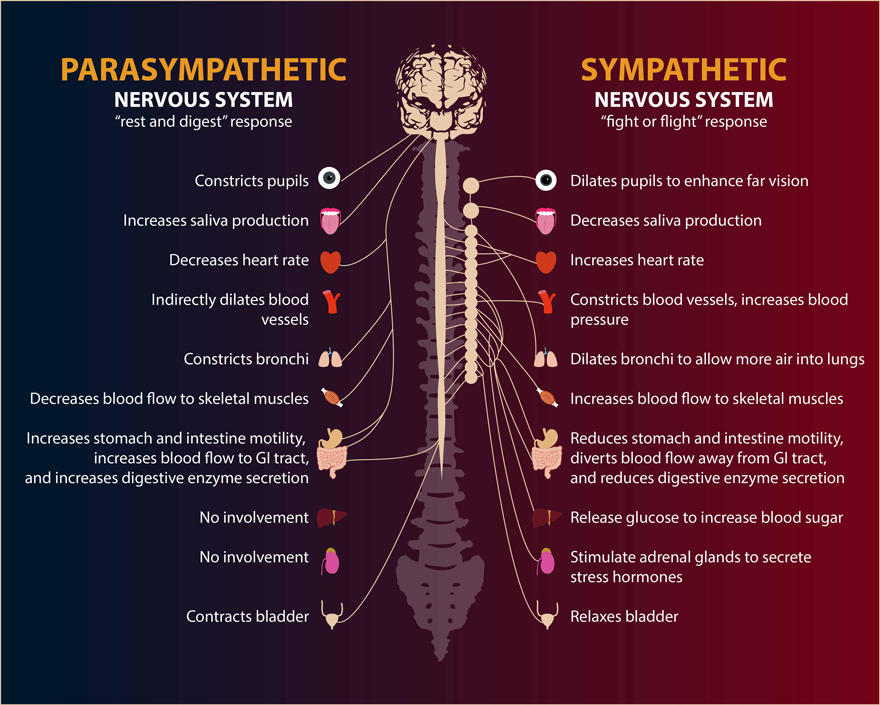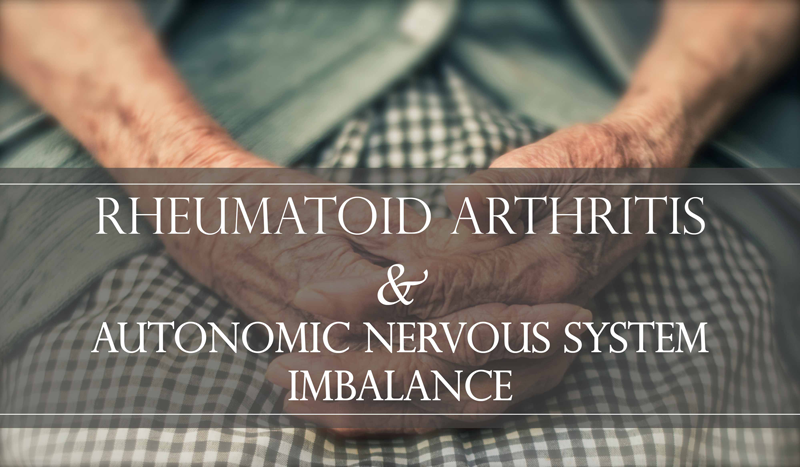The nervous system plays a role in many disease developments and progression. Rheumatoid arthritis is an autoimmune disease. It may be surprising to learn that there is a link between nervous system imbalance and rheumatoid arthritis.
The available evidence suggests that this imbalance in the nervous system happens before the development of rheumatoid arthritis (1) and is consistently found in those with rheumatoid arthritis (2). When this imbalance is reduced, rheumatoid arthritis patients respond better to treatment. (3)
So, what is this nervous system imbalance we are talking about?
We are specifically referring to imbalance of the autonomic nervous system (ANS). If you already know this, skip to the next section.

The ANS, as its name implies, is an automated part of the nervous system that modulates basic physiological functions to help us adapt to our environment. The sympathetic nervous system responds to perceived threats by increasing arousal and energy production, and inhibits digestion. The parasympathetic nervous system calms the body, returns it to regular function and promotes activities related to digestion.
These two systems generally act in opposition to the other. The sympathetic nervous system is meant to prep our body to react to crisis. Crisis should be the exception rather than the rule. If crisis and stress have become the norm, one tends to be sympathetic dominant and struggles with things like high blood pressure, poor digestion, and constipation.
How does autonomic nervous system (ANS) imbalance affect those with rheumatoid arthritis?
First of all, it’s worth mentioning that ANS dysfunction is associated with rheumatoid arthritis. Rheumatoid patients have an overly active sympathetic nervous system and reduced parasympathetic nervous system activity. (2)
Interestingly, a 2016 study (1) found that, not only was the imbalance more significant in rheumatoid patients, it was also more significant in those who weren’t affected but developed arthritis later on.
The nervous system is able to detect and regulate inflammation in tissues. (2) When paralyzed patients develop rheumatoid arthritis, they don’t develop arthritis on their paralyzed side, which is also the side the nerve supply is interrupted. (2)
Generally, stimulation of the parasympathetic nervous system releases anti-inflammatory chemicals. (2) In rheumatoid patients, an altered sympathetic response along with low parasympathetic activation creates a strong pro-inflammatory situation. (2)
Can we test this imbalance?
Yes. The activity of the ANS can be monitored, using software that tracks heart rate variability (HRV). (1, 4) If you refer back to the diagram above, you will notice that both the sympathetic and parasympathetic nervous systems play a role in controlling our heartbeats. One speeds it up and the other slows it down. Therefore, the patterns of our heart rates become a window to the function of our nervous system.
Decreased HRV is an indication of poor parasympathetic function, and is associated with many illnesses, including premature death. (5)
If you are interested in scheduling a HRV assessment, contact us.
What can we do to improve parasympathetic function?
New evidence shows that rheumatoid arthritis patients with higher parasympathetic activity respond better to their therapy. (3) Here are some natural ways to increase parasympathetic activity:
- Lavender oil: Animal studies have consistently shown that grapefruit oil increases sympathetic activity and lavender oil increases parasympathetic activity. (6) As essential oils gain popularity, there are more studies exploring the effect of lavender oil on the ANS. Lavender oil increases parasympathetic activity and results in decreased blood pressure, heart rate and skin temperature. (7) Sleep quality was also significantly improved after aromatherapy. (8)
- Yoga: Existing studies suggest that yoga increases parasympathetic activity during practices. Those who practice yoga regularly are able to maintain higher parasympathetic activity at rest, compared to those who don’t practice yoga. (9)
- Music: Mozart’s music has been shown to increase parasympathetic activity, which may explain how Mozart K.448 can help children with seizures. (10)
- Positive emotions: How exactly positive emotions affect physical health is still a mystery, but we do know that positive emotions increase parasympathetic activity. (11)
Conclusion
Although there is no cure for rheumatoid arthritis at this time, addressing some of the neurological and metabolic consequences can still greatly improve one’s function and quality of life.
References:
- Koopman FA, et al. Autonomic dysfunction precedes development of rheumatoid arthritis: a prospective cohort study. EBioMedicine. 2016 Apr;6:231-237.
- Koopman FA, et al. Restoring the balance of the autonomic nervous system as an innovative approach to the treatment of rheumatoid arthritis. Mol Med. 2011 Sep-Oct;17(9-10):937-48.
- Keepman FA, et al. Balancing the autonomic nervous system to reduce inflammation in rheumatoid arthritis. J Intern Med. 2017 Jul;282(1):64-75.
- Cygankiewicz I, Zareba W. Heart rate variability. Handb Clin Neurol. 2013;117:379-93.
- Yuen AW, Sander JW. Can natural ways to stimulate the vagus nerve improve seizure control? Epilepsy Behav. 2017 Feb;67:105-110.
- Nagai K, et al. Olfactory stimulatory with grapefruit and lavender oils change autonomic nerve activity and physiological function. Auton Neurosci. 2014 Oct; 185:29-35.
- Sayorwan W, et al. The effects of lavender oil inhalation on emotional states, autonomic nervous system, and brain electrical activity. J med Assoc Thai. 2012 Apr;95(4):598-606.
- Chien LW, Cheng SL, Liu CF. The effect of lavender aromatherapy on autonomic nervous system in midlife women with insomnia. Evid Based Complement Alternat Med. 2012;2012:740813.
- Tyagi A, Cohen M. Yoga and heart rate variability: a comprehensive review of the literature. Int J Yoga. 2016 Jul-Dec;9(2):97-113.
- Lin LC, et al. Parasympathetic activation is involved in reducing epileptiform discharges when listening to Mozart music. Clin Neurophysiol. 2013 Aug;124(8):1528-35.
- Kok EB, et al. How positive emotions build physical health: perceived positive social connections account for the upward spiral between postive emotions and vagal tone. Psychol Sci. 2013 Jul 1;24(7):1123-32.
About the Author
Dr. Lily Semrow is a Board Certified Chiropractic Neurologist who focuses on Neuro-Structural Correction. She has a B.S. in Nutrition and a doctorate in Chiropractic. She has a passion for serving families, and helping people who could not get better through traditional and alternative means.

